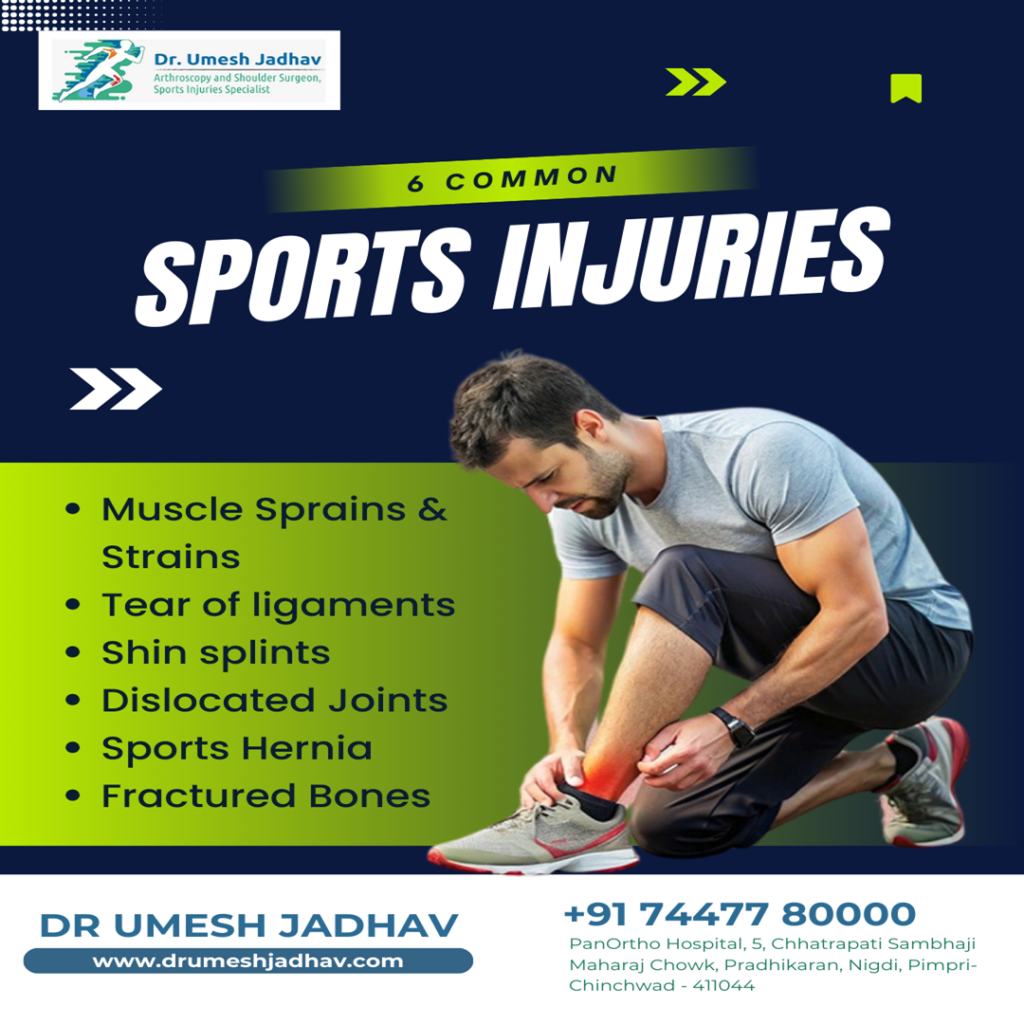Whether you’re a seasoned athlete or a weekend warrior, sports injuries can strike at any time. From minor strains to serious fractures, staying informed can help you prevent injuries and recover faster. In this post, we break down the 6 most common sports injuries, their symptoms, causes, and effective treatment methods.
1. Muscle Sprains and Strains
Muscle sprains and muscle strains are among the most frequently reported sports injuries, often caused by overuse, sudden movements, or improper technique during physical activity. Though they are often used interchangeably, they affect different parts of the musculoskeletal system:
- A muscle strain (also known as a pulled muscle) occurs when muscle fibers or tendons are overstretched or torn.
- A muscle sprain affects ligaments—the tough bands connecting bones to each other—when they are stretched or torn, usually
Causes:
- Overuse or fatigue
- Poor warm-up routines
- Sudden movements or twisting
Symptoms:
- Pain and swelling
- Limited range of motion
- Bruising or muscle weakness
Treatment:
- R.I.C.E (Rest, Ice, Compression, Elevation)
- Physical therapy
- Anti-inflammatory medications
2. Tear of Ligaments
A ligament tear usually occurs in the knees, ankles, or wrists. The ACL tear (Anterior Cruciate Ligament) is one of the most severe sports injuries.
Causes:
- Sudden impact or twisting
- High-contact sports (e.g., football, basketball)
Symptoms:
- Popping sound during injury
- Instability in the joint
- Swelling and severe pain
Treatment:
- Rest and immobilization
- Surgery (in severe cases)
- Rehabilitation and strengthening exercises
3. Shin Splints: A Common Overuse Injury in Athletes
Shin splints, medically referred to as Medial Tibial Stress Syndrome (MTSS), are characterized by pain along the inner edge of the shinbone (tibia). This condition commonly affects runners, dancers, military recruits, and athletes who participate in sports that involve repetitive lower leg impact. Shin splints occur when the muscles, tendons, and bone tissue around the tibia become inflamed due to overuse or repeated stress.
Causes:
- Overtraining
- Running on hard surfaces
- Improper footwear
Symptoms:
- Sharp or dull pain in the lower leg
- Tenderness along the shinbone
- Swelling in the lower leg
Treatment:
- Rest and ice
- Wearing proper footwear
- Stretching and strengthening exercises
4. Dislocated Joints
A joint dislocation happens when bones are forced out of their normal position, commonly affecting shoulders, fingers, and knees.
Causes:
- Falls or collisions
- High-impact sports like rugby or wrestling
Symptoms:
- Intense pain
- Swelling and bruising
- Visibly out-of-place joint
Treatment:
- Immediate medical attention to reposition the joint
- Immobilization
- Physical therapy for recovery
5. Sports Hernia (Athletic Pubalgia)
A sports hernia (athletic pubalgia) is a soft tissue injury in the groin or lower abdomen, common in athletes who perform sudden twists, sprints, or intense core movements. Unlike a traditional hernia, it doesn’t cause a visible bulge but leads to chronic groin pain. It’s often seen in sports like football, hockey, soccer, tennis, and martial arts, and can be difficult to diagnose without proper evaluation.
Causes:
- Rapid changes in direction
- Overuse of groin muscles
Symptoms:
- Chronic groin pain
- Pain during sports activity
- Tenderness in the lower abdomen
Treatment:
- Rest and physiotherapy
- Core strengthening exercises
- Surgical intervention if conservative treatment fails
6. Fractured Bones
A fractured bone occurs when there is a break, crack, or shattering of the bone due to high-impact trauma or repetitive stress. In sports, fractures commonly affect areas like the wrists, ankles, arms, and legs.
Causes:
- Direct impact
- Overuse or repetitive stress (stress fractures)
Symptoms:
- Sudden, sharp pain
- Swelling and bruising
- Inability to move or bear weight
Treatment:
- Immobilization with cast or brace
- Surgery in complex cases
- Gradual return to activity under medical guidance
Prevention Tips for Sports Injuries
- Always warm up and cool down
- Use proper sports techniques and gear
- Avoid overtraining and get adequate rest
- Stay hydrated and eat a balanced diet
- Listen to your body — rest if you’re in pain
When to See a Sports Medicine Specialist?
If you experience persistent pain, swelling, bruising, or limited mobility after a sports activity, it’s important to seek sports medicine specialist. Ignoring these symptoms can lead to long-term complications or chronic injuries.
Consult Dr. Umesh Jadhav an experienced sports medicine and orthopedic specialist in Nigdi, PCMC, for a thorough evaluation and personalized treatment plan. Early diagnosis and expert care can significantly shorten your recovery time and help you return to peak performance safely.
Final Thoughts
Whether you’re an athlete or a fitness enthusiast, understanding the most common sports injuries—like muscle sprains, ligament tears, shin splints, joint dislocations, sports hernia, and fractures—is the first step in prevention and recovery. Listen to your body, prioritize proper technique, and don’t hesitate to seek help when needed.
Book an appointment with Dr. Umesh Jadhav today to stay active, safe, and injury-free.

